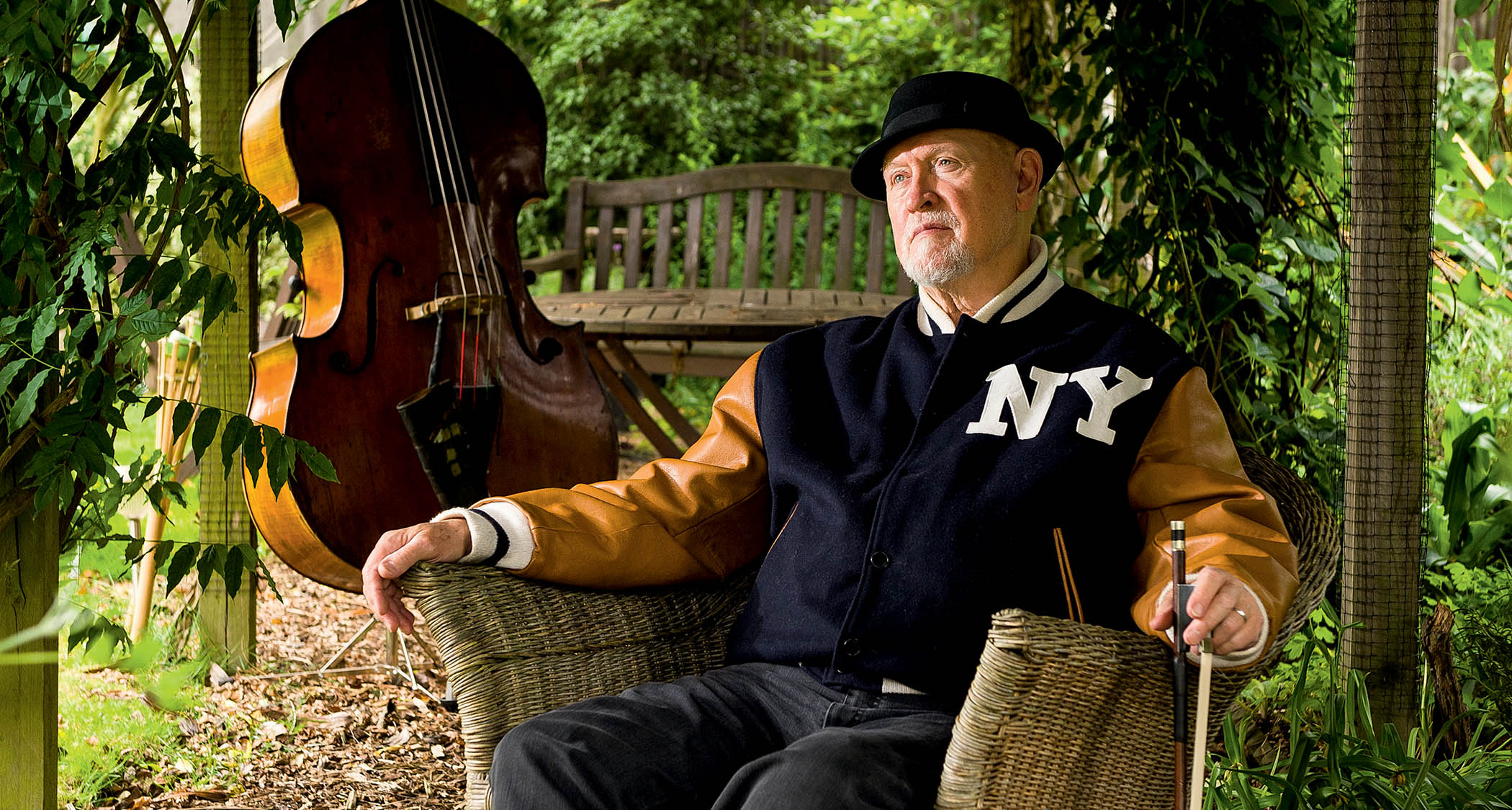How Martin supersized the Dreadnought for a Custom Shop acoustic that’s louder, more dynamic and “hits you in the chest”
If you can’t make the world’s most influential acoustic better, you can always make it bigger. Scott Sasser and Tim Teel of Martin explain the design of the awesome Super Dreadnought
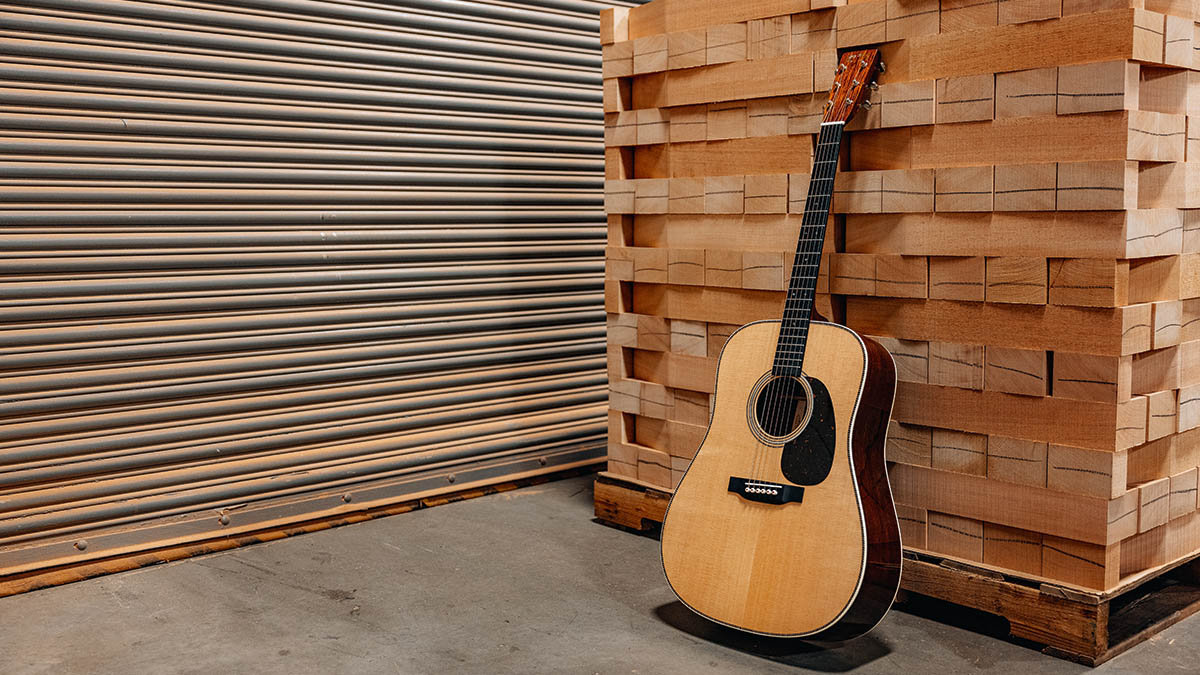
Go big or go home, as they say – and a new high-end acoustic guitar design from Martin, the company that gave birth to the Dreadnought in the early 1900s, certainly does that, though more subtly than you might think.
The Super Dreadnought, recently debuted by Martin’s Custom Shop, takes the classic square-shouldered, bass-rich design that’s been copied by nearly every acoustic maker in the world and enlarges it even further. The result is a louder, grander instrument that “hits you in the chest” when you play. But does it only boom or can it whisper, too? And how do you make a larger guitar feel comfortable under the arm of both strummers and fingerstylists alike?
These were the challenges that Scott Sasser, director of Martin’s Custom Shop, and Tim Teel, director of instrument design, faced when they upscaled the most influential acoustic in the world.
And while the initial release is limited to two identically priced Custom Shop models, one in Guatemalan rosewood and the other in koa, it seems there are plans afoot for the Super Dreadnought to become a Standard line instrument thanks to its stellar performance in the hands of a diverse range of early adopters. We join Scott and Tim to find out what the big deal is…

How did the idea for the new Super Dreadnought come about?
Tim Teel: “Fred Greene [Martin’s vice president of product] and I took a trip up to Fishman prior to the pandemic, back in 2019 or maybe a little bit before that. This was when we were trying to come up with a name for the SC, kicking around a few things. On the way up there, the radio’s on and a Black Sabbath song came on – Supernaut. So I said to Fred, ‘There you go, Fred, let’s just call it the ‘Supernaut’,’ and we had a laugh about that.
“But when we got back [to talking after] the pandemic, we were thinking, ‘Hey, we need to do something new and different.’ And Fred’s like, ‘I want to build a big guitar, I want to build the Supernaut…’ I said, ‘So you’re talking a Super Dreadnought, right?’ ‘Yeah, Super Dreadnought.’ We first developed the Super Dreadnought thinking it was going to be a Standard series launch. But then Scott was looking for a product to introduce on the Custom Expert side.”
All the latest guitar news, interviews, lessons, reviews, deals and more, direct to your inbox!
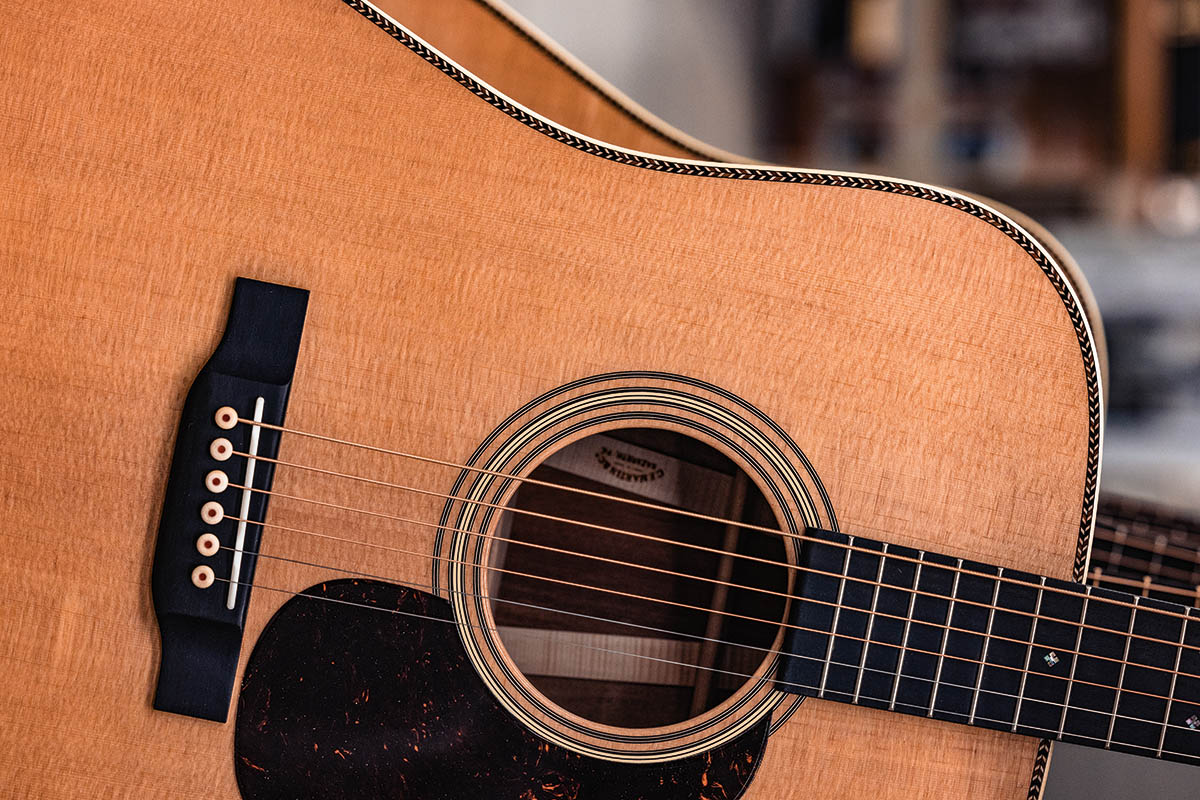
Scott Sasser: “Well, yes, Fred, as VP of product, tries to give folks a window on what he sees out in the real world. He had made the comment on numerous occasions that some manufacturers in our community were giving a lot of attention to smaller guitars, parlour shapes, and the kind of intimate, fragile, historic shapes that Martin has a catalogue full of.
“But who’s going to build one of those better than Martin? Or with more complete accuracy or history than Martin? It’s like they’re trying to recreate something that Martin has already exhibited mastery at, to be bold in that statement.
We took a leap of faith. And, at the time, was anybody asking for an even larger Dreadnought? No, but it was so cool when it made it into the hands of players around the factory
Scott Sasser
“So Fred said, ‘What if we just go the other direction? Go big. We have the history, and the capability and the know-how.’ So that seed got planted: ‘What would something bigger look like?’ The conversation had been in the atmosphere [both] in the Custom office and among the R&D folks like Tim, who then explored the maximum dimensions that we could reliably produce in the factory.
“But then the pandemic made the world weird and everything went into lockdown. Just at that moment, we were in the process of releasing 28-style Expert Models [for example, the Custom Shop Expert 000-28 1937 model – Ed] to a select group of dealers. These are heavily Authentic-inspired instruments that had some unique features.
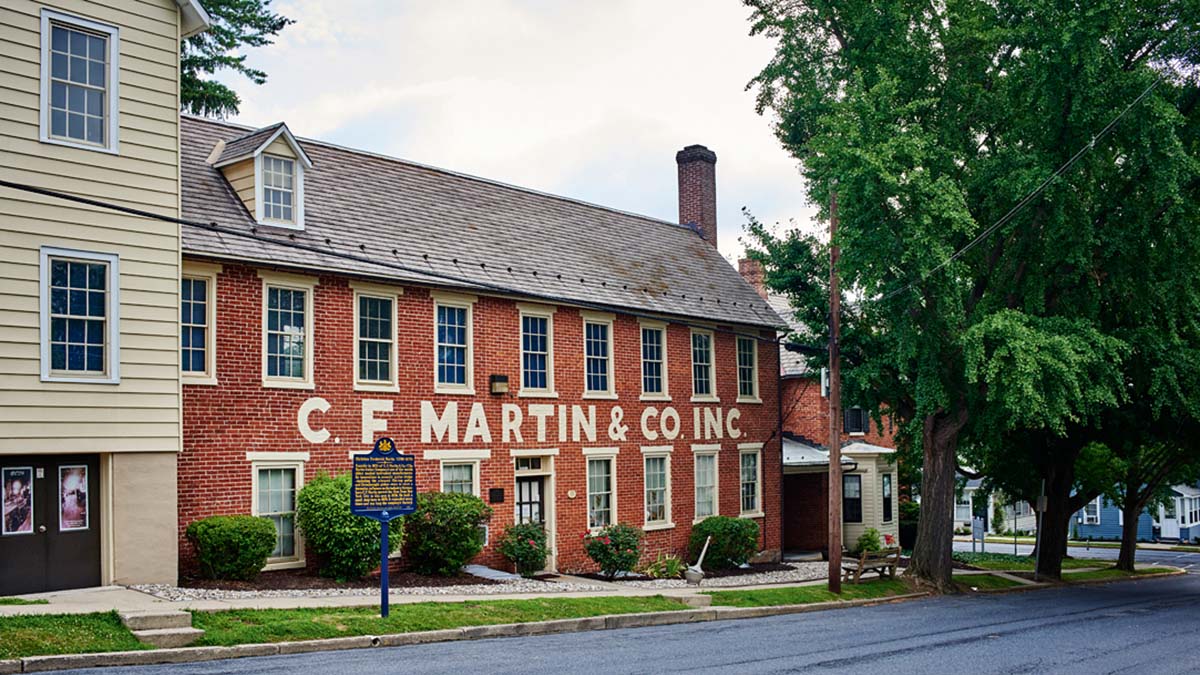
“Our pledge with this group of highly capable dealers – we call them ‘Custom Experts’ because they have close and long-standing relationships with the Custom Shop – was to regularly introduce unique products. But not instruments that are so esoteric that the world doesn’t want them or that the dealers won’t be able to sell them, but things that either they request or we believe might fall into their spectrum of preferences. And we had great success out of the gate with those 28-style instruments.
“When the following year started to come around, we had to determine what’s next, and among many possibilities was this Super Dreadnought shape. We kind of took a leap of faith. And, at the time, was anybody asking for an even larger Dreadnought? No, but it was so cool when it made it into the hands of players around the factory, and into the hands of some guests that visited, that we were like, ‘You know? This could be something. So let’s take a chance.’
“We figured there’d be some bluegrass players or some Americana, roots-rock strummers that would really like it. But once it started showing up in the hands of some of these Expert dealers, it pleasantly surprised us by crossing genres – I mean, we’ve got fingerstyle guys who are used to playing triple Os and OM guitars [who are now really into the Super Dreadnought].
“Have you seen the video produced by Russo Music? Well, the guitarist [who did the video demonstration, Scott Rieger] was just such a phenomenal player. When he opened the box, he grabbed the guitar and after the very first strum he just stopped and said, ‘I gotta tell you, I was absolutely prepared to hate this guitar – you described it to me as an even bigger Dreadnought. And it’s everything that I would never have chosen for myself.’ But he was absolutely blown away by it, and he fell in love with the koa version.”
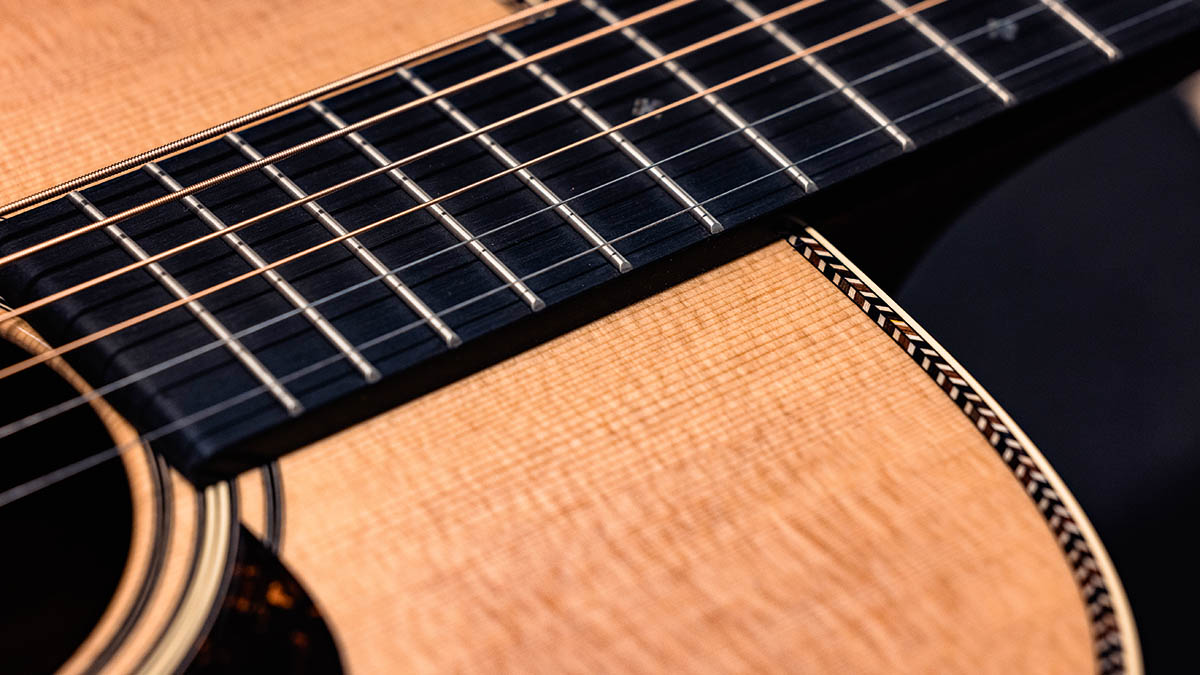
The Super Dreadnought is currently a Custom Shop guitar, but can you see it becoming a Standard production model at any point in the future?
Scott: “It will very likely see the light of day as a Standard Line product [in due course], just as we have a triple-0 or an OM or D-28. The Super D could be a body shape that appears in the 18 family or the 28 family or you name it. I mean, Martin has earned the right to experiment and have some fun. And just because we’ve made instruments in the 30s and 40s that the world is still hungry for, it doesn’t mean we can’t explore the boundaries.
“Tim and his group did just that – they were able to grow [the Dreadnought shape into an even larger instrument] and it looks so organic. It’s absolutely proportional in the body shape, down to the soundholes – because the soundhole is proportionally larger. So there are no weird angles to apologise for, no Gumby effect on the headstock or anything oddball that everybody would raise their eyebrows at.”
Tim: “The Super D doesn’t look exceptionally large until you see a Dreadnought Junior, then a regular Dreadnought and a Super Dreadnought all lined up together. It’s a nice cohesive sizing.”
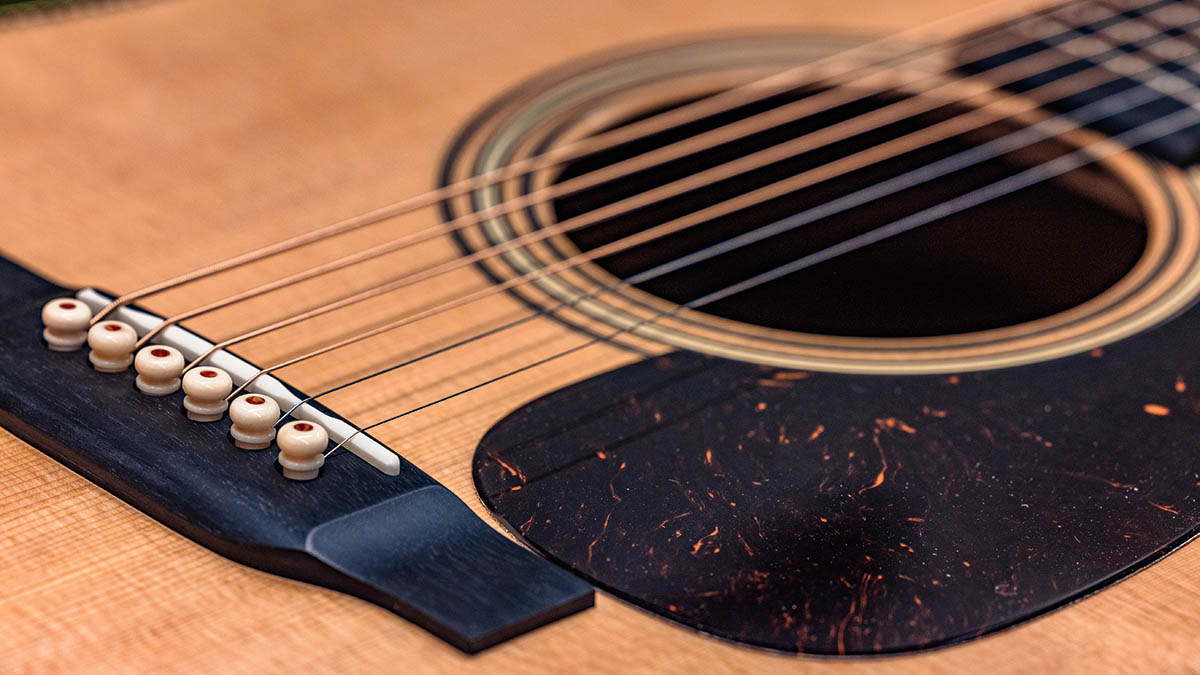
Martin is often regarded as a tradition-based brand. How does the Super Dreadnought fit into the heritage?
Tim: “We have an internal group that meets on capital [expenditure] requests, so when it came to actually putting the Super Dreadnought into production, I needed to go to the capital meeting and request money for it. I started explaining what the guitar was and I used the term Super Dreadnought. As soon as I did that, Chris Martin looked up and he said, ‘Super Dreadnought?’ I’m like, ‘Yeah,’ and he’s like, ‘Where do I sign?’
“He started to explain the reason he was so intrigued from a historical standpoint, is that the original Dreadnought was named after a class of battleship. He said, ‘I don’t know if you know this, but after that first Dreadnought class of battleship was put into service they commissioned a new class and that new class was called the Super Dreadnought.’ From his standpoint, he was just like, ‘Yeah, this is a natural progression of the instrument.’
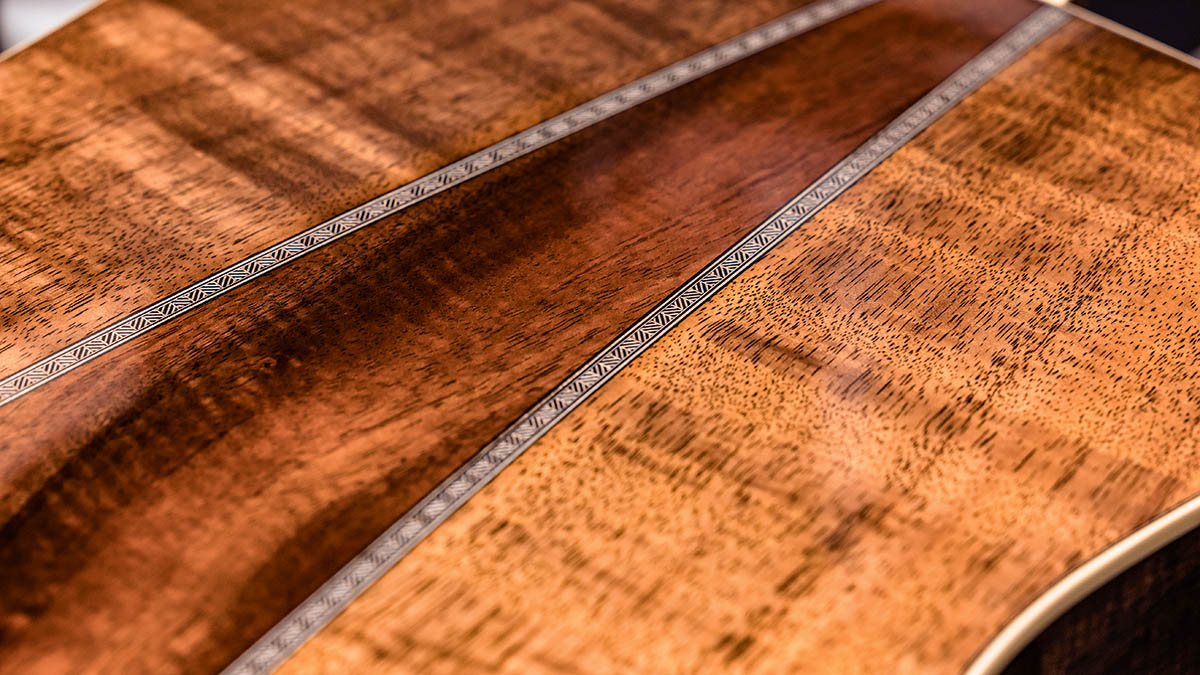
“The sound truly has that character of a gunship, just from a nuts and bolts standpoint. When we started looking at the response of the instrument compared with a standard Dreadnought our sound guy – who was working in a controlled environment in our sound room – was getting a reading on the bass side that was up to 12dB hotter.
“And then on the treble and the mids he’s getting anywhere from, say, 5dB to 8dB hotter. That’s significant because when we were testing the Liquid Metal bridge pins, we thought those were quite impressive. Those little pins can induce a 2dB to 3dB increase over a standard plastic pin… so to have something averaging about a 6dB to 9dB bump over the whole guitar, that’s super-impressive.”
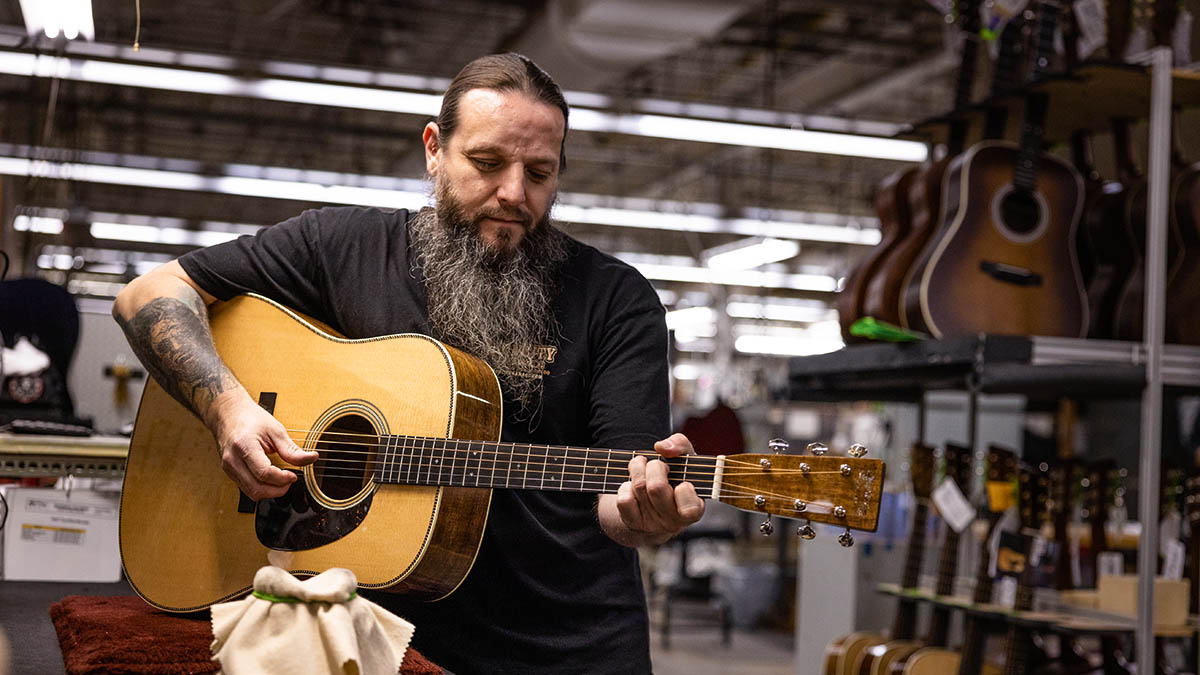
Scott: “Jason Isbell was around the factory a couple of weeks back and he played the prototype. Even with its strings that had been collecting funk for a couple of months, hanging in the rafters over Tim’s head there, he gave it a strum and he’s like, ‘Man, that really hits you right in the chest.’ He played it for an hour, with crappy strings and all, but he just wouldn’t let it go.
“That [powerful hike in volume] is real and has proven to not just be real to exceptional players like Jason but for average players, too. You can feel the instrument vibrating [more powerfully], but you can do that without having to put more effort into the instrument. It’s a bigger speaker, that’s essentially what it is. It works like the difference between a good bookshelf speaker and its standing-speaker counterpart from the same manufacturer.”
When you make an acoustic guitar bigger, you can either make its perimeter larger or increase its depth – or both. But if you increase depth, you risk making the guitar hard to reach over and thus unergonomic. How did you manage those factors with the Super Dreadnought?
“That’s a great question. You know, we play with depths for different effects, and we do have what’s called a thin-body Dreadnought. I think we did one for Beck and then there’s a couple of other ones we did. Typically, you’ll get a little less bass and a little more mids that’ll be perceived. In the case of the Super D, one thing I did not want to do is go any deeper.
“And the reason for that was I thought I was gonna get enough bass just from the perimeter enlargement. But the other reason is because I didn’t want people trying to reach over this thing to feel like it’s an even further reach [than on a standard Dreadnought]. And I think that worked to our benefit, in the sense that we got a bass boost that was more than expected, which was awesome. We got an output volume higher than expected, which was great.
“But then we also have a guitar that, even though it’s bigger in profile, is still very comfortable. As Scott alluded to earlier, some real-world players wanted to hate the thing because they thought it was going to be this huge, huge guitar. But no – and in my opinion, I think it’s just as easy to play as any other Dreadnought we have.”
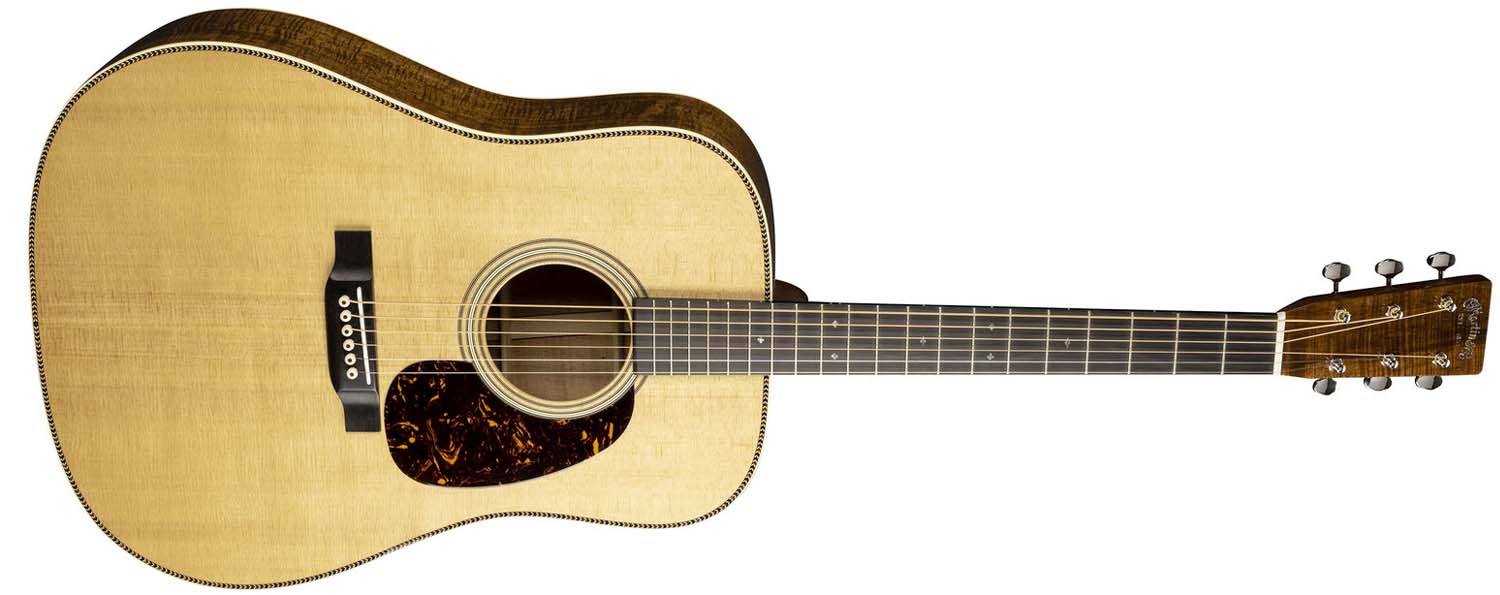
How did you make sure that, in gaining an increase in volume, you didn’t lose any dynamics and detail when playing more softly?
Tim: “There is a typical bracing formula that we use, but I massaged it a little bit, knowing some of the background on what we develop for other guitars and what works and what doesn’t. So the bracing pattern, in and of itself, is a new pattern for us because it’s a different shape and it’s in a slightly different placement.
“But if you were thinking, ‘Is it forward-shifted?’ Well, it’s a new body size, it’s a Super Dreadnought – so there is no forward or rearward shift [relative to traditional placement] – it is what it is. However, it is closer to the ‘one inch from the soundhole’ dimension that everybody’s looking for. Although the soundhole itself is just a little bit larger; it’s not a large soundhole, it’s just a tiny bit bigger.
“Our normal soundhole size is four inches and this is four and an eighth [of an inch], which means there’s a 16th-on-each-side enlargement, and overall diameter [enlargement] is an eighth of an inch, whereas a large soundhole would probably double that increase in size.”
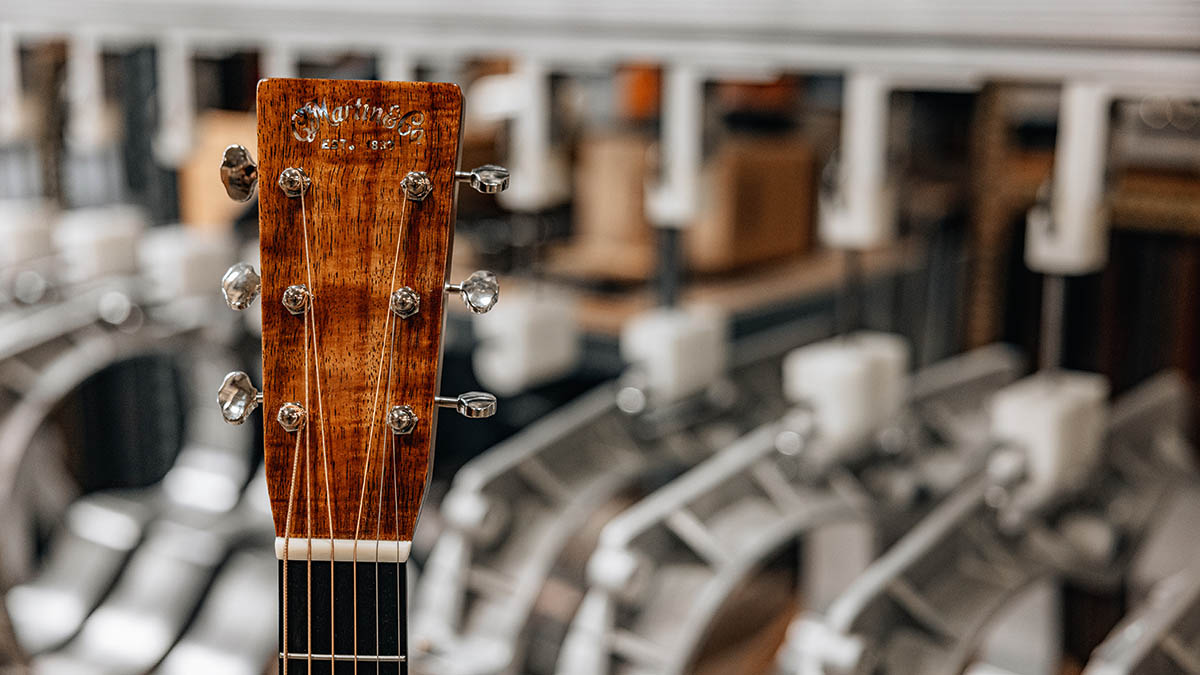
You’ve debuted the Super Dreadnought with a choice of Guatemalan rosewood or koa for its body and Sitka spruce for the top. Will the Super D design also work well with other tonewood combinations?
Tim: “I can tell you it works great on mahogany, it works great on East Indian rosewood, though Scott has chosen two woods in particular for the Custom Expert models and he also needed to do a three-piece back. That was not because it’s based on a D-35, as far as typical ‘35’ features go, but because of wood availability…”
Scott: “We had to ensure we didn’t reach a point in manufacturing where we were limited by materials for the ‘wingspan’ of the Super Dreadnought’s back. So, yeah, we had material on hand and it could have been a two-piece back.
“But, instead, looking a little forward into the future and understanding how we are sometimes limited by what Mother Nature provides, it made practical sense to do it as a three-piece back so that we wouldn’t have to halt production at any point and use a different material on a brand-new instrument that we were trying to build confidence among dealers with.
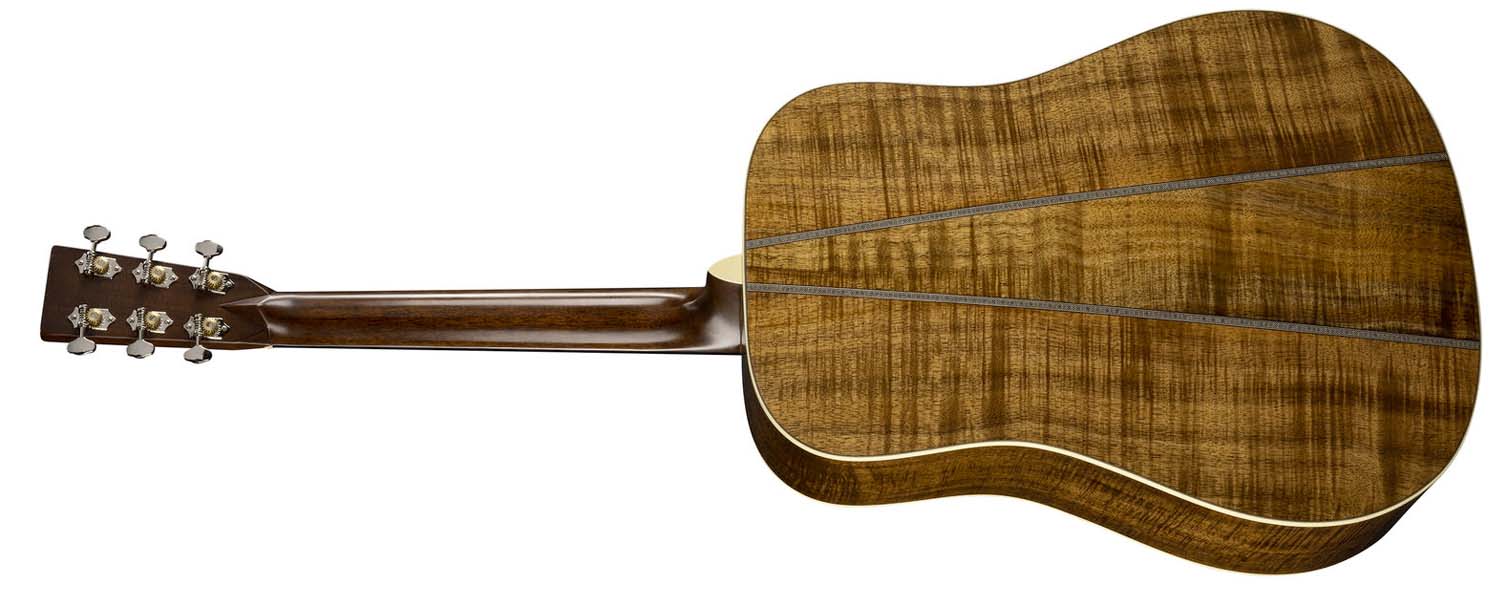
“As Tim mentioned, the rosewood performed very well and mahogany was a strong performer, too. But I wanted something that was a little more upscale. So we have the Guatemalan rosewood variant that’s on the street now and, sonically, koa is always equated with some of the most desirable characteristics of mahogany.
“So I knew I could deliver an instrument that looked great in koa while maintaining the same price point that we had with Guatemalan rosewood, so we would be able to help the dealers say, ‘Here are your two choices. They’re the same price, which do you want?’
“I just wanted to offer [two guitars] with great eye-appeal but let the price be the same… we know we’re going to be able to please customers’ ears, but if they’re going to buy with their eyes, let’s just give them the choice. ‘Here they are: A or B, they’re the same price – which do you think you can’t live without?’”
As far as larger acoustics go, most people’s reference point is a J-200. How does the Super Dreadnought compare to that?
Tim: “Yeah, so a J-200 in my head is more equivalent to our Grand Jumbo, which has a 17-inch body. Those two are more similar to me than what a J-200 would be to a Super Dreadnought – sound and everything. I mean, to me, what makes more sense is that this is a Dreadnought, a guitar we all know and love, but turned up to 12 – one past 11!”
Jamie Dickson is Editor-in-Chief of Guitarist magazine, Britain's best-selling and longest-running monthly for guitar players. He started his career at the Daily Telegraph in London, where his first assignment was interviewing blue-eyed soul legend Robert Palmer, going on to become a full-time author on music, writing for benchmark references such as 1001 Albums You Must Hear Before You Die and Dorling Kindersley's How To Play Guitar Step By Step. He joined Guitarist in 2011 and since then it has been his privilege to interview everyone from B.B. King to St. Vincent for Guitarist's readers, while sharing insights into scores of historic guitars, from Rory Gallagher's '61 Strat to the first Martin D-28 ever made.

